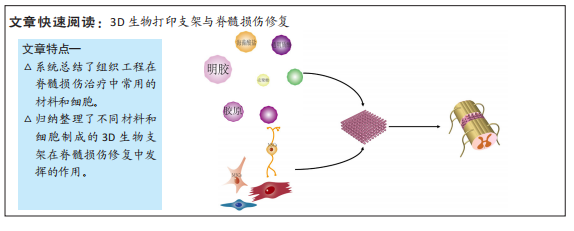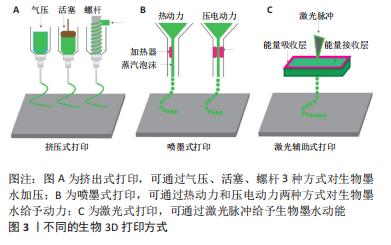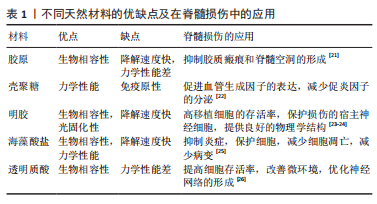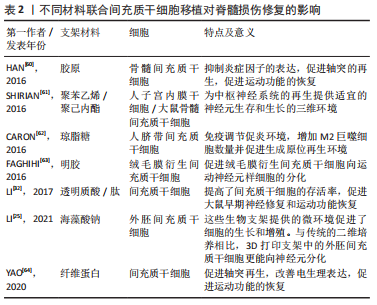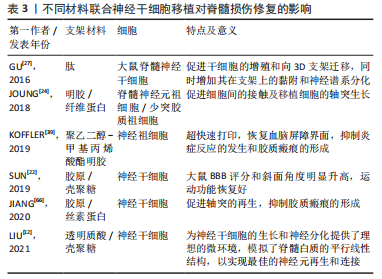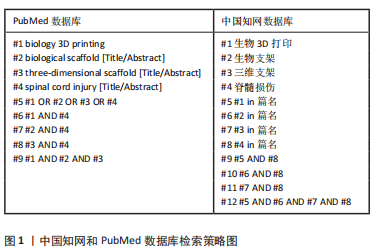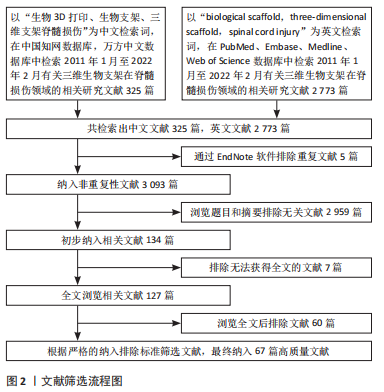[1] RAMER LM, RAMER MS, BRADBURY EJ. Restoring function after spinal cord injury: towards clinical translation of experimental strategies. Lancet Neurol. 2014;13(12):1241-1256.
[2] MCDONALD JW, SADOWSKY C. Spinal-cord injury. Lancet. 2002;359(9304):417-425.
[3] CUNHA C, PANSERI S, ANTONINI S. Emerging nanotechnology approaches in tissue engineering for peripheral nerve regeneration. Nanomedicine. 2011;7(1):50-59.
[4] SUBRAMANIAN A, KRISHNAN UM, SETHURAMAN S. Development of biomaterial scaffold for nerve tissue engineering: Biomaterial mediated neural regeneration. J Biomed Sci. 2009;16(1):108.
[5] QASIM M, CHAE DS, LEE NY. Advancements and frontiers in nano-based 3D and 4D scaffolds for bone and cartilage tissue engineering. Int J Nanomedicine. 2019;14:4333-4351.
[6] 赵瑾,袁晓燕,姚康德.组织工程多孔支架制备技术进展[J].化工进展, 2002,21(9):644-648.
[7] RICHARDS DJ, TAN Y, JIA J, et al. 3D printing for tissue engineering. Isr J Chem. 2013;53(9-10):805-814.
[8] FARZADI A, SOLATI-HASHJIN M, ASADI-EYDIVAND M, et al. Effect of layer thickness and printing orientation on mechanical properties and dimensional accuracy of 3D printed porous samples for bone tissue engineering. PLoS One. 2014;9(9):e108252.
[9] NYBERG E, RINDONE A, DORAFSHAR A, et al. Comparison of 3D-printed poly-ɛ-caprolactone scaffolds functionalized with tricalcium phosphate, hydroxyapatite, bio-oss, or decellularized bone matrix. Tissue Eng Part A. 2017;23(11-12):503-514.
[10] PEI P, QI X ,DU X , et al. Three-dimensional printing of tricalcium silicate/mesoporous bioactive glass cement scaffolds for bone regeneration. J Mater Chem B. 2016;4(46):7452-7463.
[11] BEDIR T, ULAG S, USTUNDAG CB, et al. 3D bioprinting applications in neural tissue engineering for spinal cord injury repair. Mater Sci Eng C Mater Biol Appl. 2020;110:110741.
[12] LIU X, HAO M, CHEN Z, et al. 3D bioprinted neural tissue constructs for spinal cord injury repair. Biomaterials. 2021;272:120771.
[13] HUNT NC, GROVER LM. Cell encapsulation using biopolymer gels for regenerative medicine. Biotechnol Lett. 2010;32(6):733-742.
[14] ZHU W, GEORGE JK, SORGER VJ, et al. 3D printing scaffold coupled with low level light therapy for neural tissue regeneration. Biofabrication. 2017; 9(2):025002.
[15] HEO DN, LEE SJ, TIMSINA R, et al. Development of 3D printable conductive hydrogel with crystallized PEDOT: PSS for neural tissue engineering. Mater Sci Eng C Mater Biol Appl. 2019;99:582-590.
[16] JOSE RR, BROWN JE, POLIDO KE, et al. Polyol-silk bioink formulations as two-part room-temperature curable materials for 3D printing. ACS Biomater Sci Eng. 2015;1(9):780-788.
[17] NI S, LI X, YANG P, et al. Enhanced apatite-forming ability and antibacterial activity of porous anodic alumina embedded with CaO-SiO2-Ag2O bioactive materials. Mater Sci Eng C Mater Biol Appl. 2016;58:700-708.
[18] SHAO HF, HE Y, FU JZ, et al. 3D printing magnesium-doped wolastonite/β-TCP bioceramics scaffolds with high strength and adjustable degradation. J Eur Ceram Soc. 2016;36(6):1495-1503.
[19] PEI P, WEI DX, ZHU M, et al. The effect of calcium sulfate incorporation on physiochemical and biological roperties of 3D-printed mesoporous calcium silicatecement scaffolds. Microporous Mesoporous Mater. 2017;241:11-20.
[20] PAGE H, FLOOD P, REYNAUD EG. Three-dimensional tissue cultures: current trends and beyond. Cell Tissue Res. 2013;352(1):123-131.
[21] LI XH, ZHU X, LIU XY, et al. The corticospinal tract structure of collagen/silk fibroin scaffold implants using 3D printing promotes functional recovery after complete spinal cord transection in rats. J Mater Sci Mater Med. 2021; 32(4):31.
[22] SUN Y, YANG C, ZHU X, et al. 3D printing collagen/chitosan scaffold ameliorated axon regeneration and neurological recovery after spinal cord injury. J Biomed Mater Res A. 2019;107(9):1898-1908.
[23] WANG J, KONG X, LI Q, et al. The spatial arrangement of cells in a 3D-printed biomimetic spinal cord promotes directional differentiation and repairs the motor function after spinal cord injury. Biofabrication. 2021. doi: 10.1088/1758-5090/ac0c5f.
[24] JOUNG D, TRUONG V, NEITZKE CC, et al. 3D printed stem-cell derived neural progenitors generate spinal cord scaffolds. Adv Funct Mater. 2018; 28(39):1801850.
[25] LI Y, CAO X, DENG W, et al. 3D printable Sodium alginate-Matrigel (SA-MA) hydrogel facilitated ectomesenchymal stem cells (EMSCs) neuron differentiation. J Biomater Appl. 2021;35(6):709-719.
[26] KIYOTAKE EA, THOMAS EE, HOMBURG HB, et al. Conductive and injectable hyaluronic acid/gelatin/gold nanorod hydrogels for enhanced surgical translation and bioprinting. J Biomed Mater Res A. 2022;110(2):365-382.
[27] GU Q, TOMASKOVIC-CROOK E, LOZANO R, et al. Functional 3D neural mini-tissues from printed gel-based bioink and human neural stem cells. Adv Healthc Mater. 2016;5(12):1429-1438.
[28] ZOU Y, ZHAO Y, XIAO Z, et al. Comparison of regenerative effects of transplanting three-dimensional longitudinal scaffold loaded-human mesenchymal stem cells and human neural stem cells on spinal cord completely transected rats. ACS Biomater Sci Eng. 2020;6(3):1671-1680.
[29] LIU S, XIE YY, WANG LD, et al. A multi-channel collagen scaffold loaded with neural stem cells for the repair of spinal cord injury. Neural Regen Res. 2021;16(11):2284-2292.
[30] YUE K, TRUJILLO-DE SANTIAGO G, ALVAREZ MM, et al. Synthesis, properties, and biomedical applications of gelatin methacryloyl (GelMA) hydrogels. Biomaterials. 2015;73:254-271.
[31] HOSSEINI SM, SHARAFKHAH A, KOOHI-HOSSEINABADI O, et al. Transplantation of neural stem cells cultured in alginate scaffold for spinal cord injury in rats. Asian Spine J. 2016;10(4):611-618.
[32] LI LM, HAN M, JIANG XC, et al. Peptide-tethered hydrogel scaffold promotes recovery from spinal cord transection via synergism with mesenchymal stem cells. ACS Appl Mater Interfaces. 2017;9(4):3330-3342.
[33] VENKATESAN J, KIM SK. Chitosan composites for bone tissue engineering--an overview. Mar Drugs. 2010;8(8):2252-2266.
[34] AAM BB, HEGGSET EB, NORBERG AL, et al. Production of chitooligosaccharides and their potential applications in medicine. Mar Drugs. 2010;8(5):1482-1517.
[35] GAO S, ZHAO P, LIN C, et al. Differentiation of human adipose-derived stem cells into neuron-like cells which are compatible with photocurable three-dimensional scaffolds. Tissue Eng Part A. 2014;20(7-8):1271-1284.
[36] LIU XY, CHEN C, XU HH, et al. Integrated printed BDNF/collagen/chitosan scaffolds with low temperature extrusion 3D printer accelerated neural regeneration after spinal cord injury. Regen Biomater. 2021;8(6):rbab047.
[37] KAPLAN B, MERDLER U, SZKLANNY AA, et al. Rapid prototyping fabrication of soft and oriented polyester scaffolds for axonal guidance. Biomaterials. 2020;251:120062.
[38] HUANG J, YAP N, WALTER M, et al. 3D-printed polypyrrole microneedle arrays for electronically controlled transdural drug release. ACS Biomater Sci Eng. 2022;8(4):1544-1553.
[39] KOFFLER J, ZHU W, QU X, et al. Biomimetic 3D-printed scaffolds for spinal cord injury repair. Nat Med. 2019;25(2):263-269.
[40] HSIEH FY, LIN HH, HSU SH. 3D bioprinting of neural stem cell-laden thermoresponsive biodegradable polyurethane hydrogel and potential in central nervous system repair. Biomaterials. 2015;71:48-57.
[41] GUO S, REDENSKI I, LEVENBERG S. Spinal cord repair: from cells and tissue engineering to extracellular vesicles. Cells. 2021;10(8):1872.
[42] ZAKRZEWSKI W, DOBRZYŃSKI M, SZYMONOWICZ M, et al. Stem cells: past, present, and future. Stem Cell Res Ther. 2019;10(1):68.
[43] HUANG L, FU C, XIONG F, et al. Stem cell therapy for spinal cord injury. Cell Transplant. 2021;30:963689721989266.
[44] JOHNSON LDV, PICKARD MR, JOHNSON WEB. The comparative effects of mesenchymal stem cell transplantation therapy for spinal cord injury in humans and animal models: a systematic review and meta-analysis. Biology (Basel). 2021;10(3):230.
[45] LEE SJ, ESWORTHY T, STAKE S, et al. Advances in 3D bioprinting for neural tissue engineering. Adv Biosys. 2018;2:1700213.
[46] AMBESI-IMPIOMBATO FS, PARKS LA, COON HG. Culture of hormone-dependent functional epithelial cells from rat thyroids. Proc Natl Acad Sci U S A. 1980;77(6):3455-3459.
[47] ZAREPOUR A, HOOSHMAND S, GÖKMEN A, et al. Spinal cord injury management through the combination of stem cells and implantable 3D bioprinted platforms. Cells. 2021;10(11):3189.
[48] CHEN G, LV Y, GUO P, et al. Matrix mechanics and fluid shear stress control stem cells fate in three dimensional microenvironment. Curr Stem Cell Res Ther. 2013;8(4):313-323.
[49] PEK YS, WAN AC, YING JY. The effect of matrix stiffness on mesenchymal stem cell differentiation in a 3D thixotropic gel. Biomaterials. 2010;31(3): 385-391.
[50] OCANSEY DKW, PEI B, YAN Y, et al. Improved therapeutics of modified mesenchymal stem cells: an update. J Transl Med. 2020;18(1):42.
[51] BARA JJ, RICHARDS RG, ALINI M, et al. Concise review: bone marrow-derived mesenchymal stemcells change phenotype following in vitro culture: implications for basic research and the clinic. Stem cells. 2014;32(7): 1713-1723.
[52] OLIVEIRA MS, BARRETO-FILHO JB. Placental-derivedstem cells: culture, differentiation and challenges. World J Stem Cells. 2015;7(4):769-775.
[53] TOKIKO NI, HE HP. Umbilical cordderived mesenchymal stem cells: Their advantages andpotential clinical utility. World J Stem Cells. 2014;6(2): 195-202.
[54] HAN S, XIAO Z, LI X, et al. Human placenta-derived mesenchymal stem cells loaded on linear ordered collagen scaffold improves functional recovery after completely transected spinal cord injury in canine. Sci China Life Sci. 2018;61(1):2-13.
[55] AN N, YANG J, WANG H, et al. Mechanism of mesenchymal stem cells in spinal cord injury repair through macrophage polarization. Cell Biosci. 2021; 11(1):41.
[56] ZENG X, QIU XC, MA YH, et al. Integration of donor mesenchymal stem cell-derived neuronlike cells into host neural network after rat spinal cordtransection. Biomaterials. 2015;53:184-201.
[57] WISLET-GENDEBIEN S, WAUTIER F, LEPRINCE P, et al. Astrocytic and neuronal fate of mesenchymal stem cells expressing nestin. Brain Res Bull. 2005; 68(1-2):95-102.
[58] MUKHAMEDSHINA YO, GRACHEVA OA, MUKHUTDINOVA DM, et al. Mesenchymal stem cells and the neuronal microenvironment in the area of spinal cord injury. Neural Regen Res. 2019;14(2):227-237.
[59] ZHANG K, LIU Z, LI G, et al. Electro-acupuncture promotes the survival and differentiation of transplanted bone marrow mesenchymal stem cells pre-induced with neurotrophin-3 and retinoic acid in gelatin sponge scaffold after rat spinal cord transection. Stem Cell Rev Rep. 2014;10(4):612-625.
[60] HAN S, WANG B, LI X, et al. Bone marrow-derived mesenchymal stem cells in three-dimensional culture promote neuronal regeneration by neurotrophic protection and immunomodulation. J Biomed Mater Res A. 2016;104(7):1759-1769.
[61] SHIRIAN S, EBRAHIMI-BAROUGH S, SABERI H, et al. Comparison of capability of human bone marrow mesenchymal stem cells and endometrial stem cells to differentiate into motor neurons on electrospun poly (ε-caprolactone) Scaffold. Mol Neurobiol. 2016;53(8):5278-5287.
[62] CARON I, ROSSI F, PAPA S, et al. A new three dimensional biomimetic hydrogel to deliver factors secreted by human mesenchymal stem cells in spinal cord injury. Biomaterials. 2016;75:135-147.
[63] FAGHIHI F, MIRZAEI E, AI J, et al. Differentiation potential of human chorion-derived mesenchymal stem cells into motor neuron-like cells in two- and three-dimensional culture systems. Mol Neurobiol. 2016;53(3):1862-1872.
[64] YAO S, HE F, CAO Z, et al. Mesenchymal stem cell-laden hydrogel microfibers for promoting nerve fiber regeneration in long-distance spinal cord transection injury. ACS Biomater Sci Eng. 2020;6(2):1165-1175.
[65] FAN L, LIU C, CHEN X, et al. Directing induced pluripotent stem cell derived neural stem cell fate with a three-dimensional biomimetic hydrogel for spinal cord injury repair. ACS Appl Mater Interfaces. 2018;10(21):17742-17755.
[66] JIANG JP, LIU XY, ZHAO F, et al. Three-dimensional bioprinting collagen/silk fibroin scaffold combined with neural stem cells promotes nerve regeneration after spinal cord injury. Neural Regen Res. 2020;15(5):959-968.
[67] KATOH H, YOKOTA K, FEHLINGS MG. Regeneration of spinal cord connectivity through stem cell transplantation and biomaterial scaffolds. Front Cell Neurosci. 2019;13:248. |
